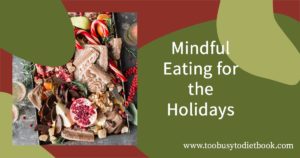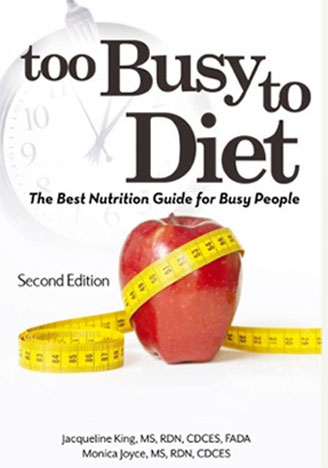Mindful Eating for the Holidays
in The Too Busy to Diet Blog on December 9, 2021

Intuitive eating has become a hot topic during recent years, especially through the pandemic as many people stayed home and tried new ways to become more aware of their eating habits and focus on their overall health.
As part of healthy lifestyle changes for long-term health, intuitive eating has recently been discussed in online articles and on television during health segments in the local news.
Many people are trying to achieve a balance between eating what they want when they are hungry and staying on a schedule to avoid overeating at each meal.
Intuitive eating allows a person to follow and trust their physical hunger cues and build a healthier body image and relationship with food. This type of nutrition intervention is not intended for weight loss, it is more about changing eating behaviors.
With the holidays in full swing, it is easy for many of us to overindulge in foods that may not be the best for our health. Let’s take a look at how mindful eating strategies can help us get through this season with nourishing choices and maybe even develop healthy eating skills for the future.
According to King & Joyce (2021), there are 6 categories to mindful eating:
1. Eating environment:
- Decompress or meditate before meals
- Sit at the table
- Keep healthy foods within reach
- Food presentation – arrange an appealing plate
2. Hunger cues & feelings:
- Learn your body’s signals for hunger and fullness
- Recognize satisfaction
- Find a distraction if not truly hungry
3. Presence and focus:
- Limit distractions
- Avoid other activities like reading or watching tv
4. Awareness:
- Chew slowly
- Taste each bite
- How does the food make you feel?
5. Food characteristics:
- Aroma, flavor, texture, temperature, spicy/salty
- How is each food different?
6. Thought acknowledgement:
- Guilt – there are no “bad foods”
- Rules – eating isn’t all or nothing, so treats can be enjoyed
- Feelings – positive and negative are ok, try to think about possible triggers
Some other strategies include:
- Planning and preparing your own meals
- Keeping pre-cut or frozen fruits/veggies on hand
- Enjoying the cooking experience – sensory signals like colors, smells, flavors
- Eating smaller amounts of a favorite indulgence
- Keeping water close by to avoid wanting sugary drinks
- Asking yourself the reason you are wanting to eat a certain food (physical hunger or emotional)
- Choosing foods that take longer to prepare and eat
- Shopping when not hungry
References:
Duyff, R.L. (2017). Complete Food & Nutrition Guide. Academy of Nutrition and Dietetics. 78, 642-643.
King, J., & Joyce, M. (2021). Too busy to diet: The Best Nutrition Guide for Busy People. Jacqueline King. 72-73.
Tamara Graham, Dietetic Student, Virginia Tech University
Buy the Too Busy to Diet book
Get your copy of the definitive diet reference guide and healthy eating book today. Stop reading those misleading fad diet books and read an easy to follow book on how to lose weight and keep it off from actual Registered Dietitians.

Recent Posts
- Barbeque Turkey Meatloaf
- Pescado a la Veracruzana
- Juicy Pork Chops
- Rotasserie Chicken Casserole
- Grilled Salmon & Blueberry Salad